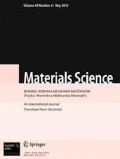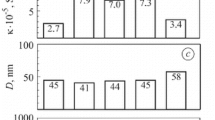We reveal the positive influence of cyclic redox treatment (redox cycling) at 600°C on the strength and electric conductivity of anode substrates for ceramic fuel cells. As a result of this treatment of ceramic anodes of the 10Sc1CeSZ–50NiО and 8YSZ–50NiO systems, which includes the stages of heating up to a fixed temperature in a vacuum or in inert gases, reduction of the preheated material in hydrogen-containing atmospheres, degassing, and oxidation in air at the same temperature, we formed structures guaranteeing the improved physicomechanical properties (strength and electric conductivity) of these products.



Similar content being viewed by others
References
D. Sarantaridis and A. Atkinson, “Redox cycling of Ni-based solid oxide fuel cell anodes: a review,” Fuel Cells, No. 3, 246–258 (2007).
M. Ettler, H. Timmermann, J. Malzbender, et al., “Durability of Ni anodes during reoxidation cycles,” J. Power Sources, 195, 5452–5467 (2010).
E. Brodnikovs’kyi, B. Vasyliv, O. Ostash, and O. Vasyl’ev, “Mechanical behavior of Ni–ZrO2 anodes for ceramic fuel cells,” in: V. V. Panasyuk (editor), Fracture Mechanics of Materials and Strength of Structures [in Ukrainian], Physicomechanical Institute, Ukrainian National Academy of Sciences, Lviv (2009), pp. 515–520.
O. Ostash, O. Vasyl’ev, B. Vasyliv, et al., “Influence of hydrogen-containing media on the physicomechanical properties of materials of fuel cells,” in: V. V. Panasyuk (editor), Fracture Mechanics of Materials and Strength of Structures [in Ukrainian], Physicomechanical Institute, Ukrainian National Academy of Sciences, Lviv (2009), pp. 623–630.
B. D. Vasyliv, “A procedure for the investigation of mechanical and physical properties of ceramics under the conditions of biaxial bending of a disk specimen according to the ring–ring scheme,” Fiz.-Khim. Mekh. Mater., 45, No. 4, 89–92 (2009); English translation: Mater. Sci., 45, No. 4, 571–575 (2009).
W. Fischer, J. Malzbender, G. Blass, and R. W. Steinbrech, “Residual stresses in planar solid oxide fuel cells,” J. Power Sources, 150, 73–77 (2005).
Y. B. Matus, L. C. De Jonghe, C. P. Jacobson, and S. J. Visco, “Metal-supported solid oxide fuel cell membranes for rapid thermal cycling,” Solid State Ionics, 176, 443–449 (2005).
O. P. Ostash, B. D. Vasyliv, V. Ya. Podhurs’ka, et al., “Optimization of the properties of 10Sc1CeSZ–NiO composite by the redox treatment,” Fiz.-Khim. Mekh. Mater., 46, No. 5, 76–81 (2010); English translation: Mater. Sci., 46, No. 5, 653–658 (2011).
B. D. Vasyliv, O. P. Ostash, V. Ya. Podhurs’ka, and O. D. Vasyl’ev, Method of Treatment of NiO-Containing Anodes of a Solid Oxide Fuel Cell [in Ukrainian], Patent of Ukraine No. 78992, Published on 10.04.13, Bulletin No. 7.
M. Ettler, G. Blaβ, and N. H. Menzler, “Characterization of Ni–YSZ-cermets with respect to redox stability,” Fuel Cells, No. 5, 349–355 (2007).
Y. Zhang, B. Liu, B. Tu, et al., “Understanding of redox behavior of Ni–YSZ cermets,” Solid State Ionics, 180, 1580–1586 (2009).
A. Faes, A. Nakajo, A. Hessler-Wyser, et al., “Redox study of anode-supported solid oxide fuel cell,” J. Power Sources, 193, 55–64 (2009).
A. Faes, H. L. Frandsen, M. Pihlatie, et al., “Curvature and strength of Ni–YSZ solid oxide half-cells after redox treatments,” J. Fuel Cell Sci. Technol., 7, 1–7 (2010).
V. Vedarsi, J. L. Young, and V. I. Birss, “A possible solution to the mechanical degradation of Ni-yttria stabilized zirconia anode-supported solid oxide fuel cells due to redox cycling,” J. Power Sources, 195, 5534–5542 (2010).
D. Waldbillig, A. Wood, and D. G. Ivey, “Electrochemical and microstructural characterization of the redox tolerance of solid oxide fuel cell anodes,” J. Power Sources, 145, 206–215 (2005).
Y. Wang, M. E. Walter, K. Sabolsky, et al., “Effects of powder sizes and reduction parameters on the strength of Ni–YSZ anodes,” Solid State Ionics, 177, 1517–1527 (2006).
M. Radovic and E. Lara-Curzio, “Mechanical properties of tape cast nickel-based anode materials for solid oxide fuel cells before and after reduction in hydrogen,” Acta Mater., 52, 5747–5756 (2004).
L. J. Van der Pauw, “A method of measuring specific resistivity and Hall effect of discs of arbitrary shape,” Philips Res. Rep., 13, 1–9 (1958).
B. D. Vasyliv, “Improvement of the electric conductivity of the material of anode in a fuel cell by the cyclic redox thermal treatment,” Fiz.-Khim. Mekh. Mater., 46, No. 2, 117–120 (2010); English translation: Mater. Sci., 46, No. 2, 260–264 (2010).
J. W. Fergus, R. Hui, X. Li, et al. (editors), Solid Oxide Fuel Cells. Materials Properties and Performance, CRC Press (2009).
Y. Zhang, B. Liu, B. Tu, et al., “Redox cycling of Ni–YSZ anode investigated by TPR technique,” Solid State Ionics, 176, 2193–2199 (2005).
H. J. Goldschmidt, Interstitial Alloys, Plenum Press, New York (1967).
R. M. C. Clemmer and S. F. Corbin, “The influence of pore and Ni morphology on the electrical conductivity of porous Ni/YSZ composite anodes for use in solid oxide fuel cell applications,” Solid State Ionics, 180, 721–730 (2009).
J. H. Yu, G. W. Park, S. Lee, and S. K. Woo, “Microstructural effects on the electrical and mechanical properties of Ni–YSZ cermet for SOFC anode,” J. Power Sources, 163, 926–932 (2007).
S. Mosch, N. Trofimenko, M. Kusnezoff, et al., “Performance and stability of SOFC anode prepared by co-precipitation,” Solid State Ionics, 179, 1606–1610 (2008).
Author information
Authors and Affiliations
Corresponding author
Additional information
Translated from Fizyko-Khimichna Mekhanika Materialiv, Vol. 49, No. 2, pp. 5–13, March–April, 2013.
Rights and permissions
About this article
Cite this article
Vasyliv, B.D., Podhurs’ka, V.Y., Ostash, O.P. et al. Influence of Reducing and Oxidizing Media on the Physicomechanical Properties of ScCeSZ–NiO and YSZ–NiO Ceramics. Mater Sci 49, 135–144 (2013). https://doi.org/10.1007/s11003-013-9593-3
Received:
Published:
Issue Date:
DOI: https://doi.org/10.1007/s11003-013-9593-3




